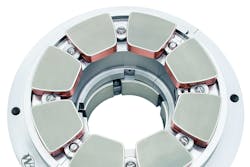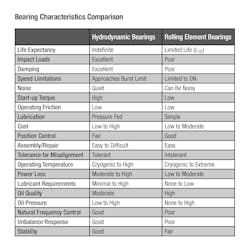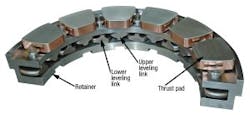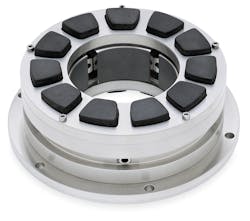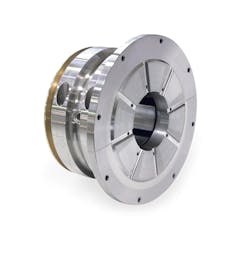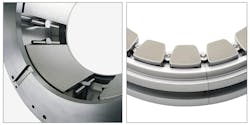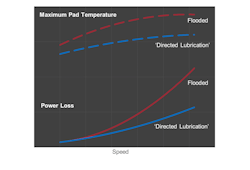How materials and design affect the life of a bearing
Bearings are a critical component in equipment reliability, efficiency and life. The majority of rotating process equipment today relies on rolling element bearings or fluid film bearings to counteract gravity and other forces in the equipment and allow the shaft to rotate freely. Selecting the right bearing for the equipment and application is essential to the successful operation of that equipment.
Table 1. Operators can compare the qualities of hydrodynamic and rolling element bearings.
A key difference between rolling element bearings and fluid film bearings when it comes to process equipment maintenance is the expected life of the bearings. Rolling element bearings typically have a predictable life based on the operating conditions. When properly designed and maintained, fluid film bearings can operate for decades. Additional comparisons of rolling element and fluid film bearing characteristics, such as lubrication needs and the ability to handle impact loads, are provided in Table 1.
The proper selection of materials and mechanical design is the foundation for a fluid film bearing’s long life. Typical factors that affect material selection include load, speed, operating temperature, insulation requirements, and lubricant type and cleanliness. Depending on the requirements, material options include babbitt (also known as whitemetal), bronze, aluminum tin, polymer, ceramic, cermet
and diamond.
For the mechanical design, the fluid film bearing designer must not only consider the proper sizing of the bearing to handle the loads and minimize the power loss but also incorporate features to optimize the formation of film and tune the dynamic characteristics of the bearing. Tuning the bearing’s characteristics improves the performance of the
process equipment.
Basic operating principle
The stationary surface of a fluid film bearing is separated from the rotating surface by a thin film of lubricant, such as oil, air, water or process fluid. In hydrodynamic fluid film bearings, the film pressure that separates the surfaces and counters loads is created by the relative motion (rotation) of the surfaces as the lubricant is pulled into a converging geometry between the surfaces. Because of this separating force, surface contact does not occur during normal operation, reducing wear and power loss compared to surface-to-surface contact.
A self-leveling tilt pad thrust bearing can accommodate misalignment.
Thrust bearings counteract axial loads, which are loads along the axis of rotation, while journal bearings support radial loads, which are perpendicular to the axis of rotation. The materials and design of both thrust and journal fluid film bearings are selected to optimize the bearing geometry for increased efficiency of the process equipment and fewer demands on the ancillary equipment.
Materials
Selecting a fluid film bearing’s materials of construction relies on two primary factors: application requirements and operating environment.
Babbitt, particularly tin-based alloys, is often the material of choice for fluid film bearings in process equipment when oil is the lubricant. Babbitt exhibits conformability, compatibility and embedability. These qualities reduce the likelihood of damage to the shaft during start-up and shutdown, or from upset conditions, misalignment or the occasional ingestion of contaminants. Because babbitt loses strength as temperature increases, the surface temperatures of these bearings are often limited to 130°C (266°F). Further, using babbitt in applications with high dynamic loads can be limited due to its relatively low fatigue strength. For the most part, however, babbitt has gained wide acceptance in the process equipment industry.
This combination tilt pad bearing has solid polymer thrust pads and polymer-lined journal pads.
Bronze can be used when operating temperatures are higher than babbitt’s limit. Oil-lubricated bronze bearings are common in process equipment applications where the bearing surface can reach 150°C (302°F) and in some cases even higher. Bronze does not have the conformability and embedability of babbitt though. This can lead to shaft or bearing damage when contaminants or misalignment are present. In addition, care must be taken when selecting the material of the rotating surface when using bronze bearings to limit the potential of damage to the rotating components.
For rotating and reciprocating process equipment that requires higher temperature or better conformability and embedability capabilities than bronze, aluminum alloyed with tin can be used as the bearing material. Aluminum tin can operate at higher temperatures than babbitt, up to 160°C (320°F), and does not fatigue as readily. Babbitt and aluminum tin are applied to steel for added strength or to chromium copper to enhance heat transfer. Both can be used against a variety of rotating components, including mild steels.
A taper land fixed profile thrust and tilt pad journal combination bearing
Engineered polymers as solid components or as a lining on steel backing are also widely accepted in process equipment. Polymer bearings exhibit embedability and conformability, similar to babbitt bearings, and they can operate at higher temperatures and loads. Because they work with relatively thin films, polymer thrust bearings are often used in oil-lubricated applications with unit loads up to 8 megapascals (1160 psi), which is approximately twice the load typically accepted by babbitt bearings, and temperatures up to 200°C (392°F).
Polymer bearings also are less susceptible to chemical attack than babbitt, insulate against electrical currents and successfully operate in a variety of lubricants, including water and process fluids. With the right material composition, polymer bearings can withstand film disruptions due to overload or temporary loss of lubrication.
When high temperatures, corrosive materials or contaminated lubricants rule out the use of babbitt, aluminum tin, bronze and polymer, fluid film bearings can be manufactured with extremely hard surfaces. Ceramics, cermets and diamond have been successfully deployed when operating temperatures exceed 200°C (392°F), when films are very thin and/or when abrasives are present. Unlike babbitt, aluminum tin and polymer, which can operate against mild steels and other traditional shaft materials, ceramic and cermet require deliberate material selection for both the rotating and stationary surfaces to obtain the desired life and performance of the bearings, especially when abrasives are present or films are extremely thin.
The best material for bearings may vary even in the same assembly, and material alone will not guarantee performance. The carefully selected material(s) must be paired with an optimum mechanical design.
Bearing design
The formation of film is critical to the life and performance of a fluid film bearing. A viscous lubricant, the relative motion between the surfaces and the converging geometry of the bearing are critical factors for the film’s development. Together, these create the pressure to counteract gravity and other forces acting on the shaft.
Journal (left) and thrust (right) bearings showing two styles of directed lubrication.
Although axial loads can be supported with flat bearing faces, typically a geometry is machined into the surface of a fixed profile thrust bearing to create a converging wedge and increase the bearing load capacity. A fixed geometry is designed for a specific condition, so tilt pad thrust bearings are often used to accommodate changing conditions. Self-leveling tilt pad thrust bearings accommodate misalignment between the bearing and the collar by equalizing load between pads.
Due to the dissimilar diameters of the bearing and shaft, a journal bearing naturally has a converging wedge when the shaft is not centered in the bearing. For improved static and dynamic performance, a defined profile can be machined into the journal bearing to develop the proper film. Journal tilt pads are often used if stability is an issue, if varying conditions must be accommodated or if other bearing performance parameters require optimization.
Switching from a lightly loaded bearing with flooded lubrication (point A) to an optimized smaller bearing with directed lubrication (point B) can significantly reduce power loss.
Thrust and journal bearings are sized to handle application load requirements and fit the given envelope. Other features can be optimized to achieve specific static performance in thrust bearings and dynamic and static performance in journal bearings. Pad arc, or the portion of the pad that develops pressure, can be adjusted to affect power loss and temperature. The offset, or the distance from the leading edge to the pivot as compared to the pad arc, has a significant effect on the formation of the film and can impact bearing temperatures, power loss, and, in the case of journal bearings, dynamic performance.
In tilt pad journal bearings specifically, temperatures, power loss and dynamic performance can be greatly affected by the bearing clearance (the difference between the bearing bore and shaft diameter), the length of the bearing and preload. Preload represents the deviation of the machined-in pad bore to the assembled bearing bore. It is positive when the pad bore is greater than the bearing bore, zero when the pad and bearing bore are the same, and negative when the pad bore is smaller than the bearing bore. If the preload is positive, a converging wedge forms. A negative preload restricts flow into the pad and is
not recommended.
On both journal and thrust tilt pad bearings, the pivot is selected based on specific needs, such as the required life of the pivot (stress), stiffness and ease of pivot tilt in one or more directions. Common pivot types are point contact, line contact, ball and socket, and flexure pivot. Each of these has distinct benefits.
Another design option that significantly affects bearing performance is the method of introducing lubricant into the bearing and removing it. By supplying lubricant to the leading edge of the tilt pad and allowing the lubricant to freely exit the bearing and its housing, directed lubrication bearings operate with lower power losses and at lower operating temperatures than flooded bearings, where the lubricant is typically fed into the bearing away from the film and flow out of the bearing is restricted. Flooded lubrication creates lubricant shearing outside the film that does not contribute to the load carrying capacity of the bearing.
Bringing it all together
Combining select materials and design features will optimize performance further than either materials or design features on their own. For example, combining directed lubrication with advanced material bearings — which are capable of handling thinner films, higher temperatures and therefore higher loads — can greatly reduce power loss compared to a flooded design with traditional bearing materials such as babbitt. Using advanced materials allows for a smaller bearing and the use of lower viscosity fluid, even process fluid, thus reducing power loss. If power loss reduction is not required, a higher safety margin can be achieved.
With the right material(s) and design, fluid film bearings can offer first-rate dynamic performance, low friction, minimal to no wear and long life, making them the right choice to meet the demands of today’s process equipment.
Barry J. Blair is chief engineer at Waukesha Bearings, an operating company of Dover. He is responsible for fluid film bearing research and development, including new products and refining bearing design tools and methods.
